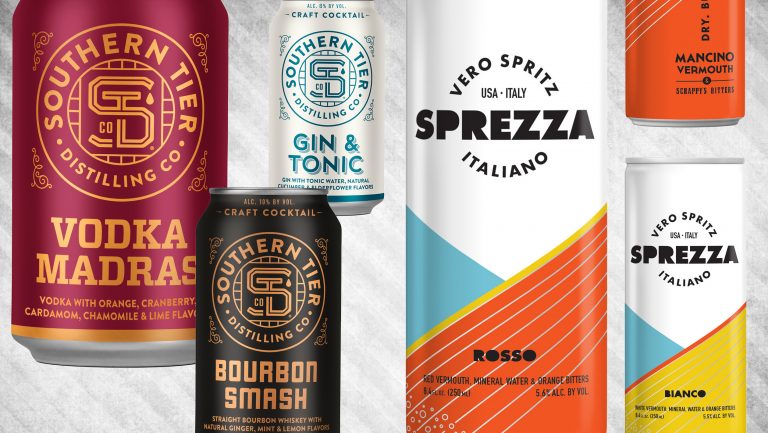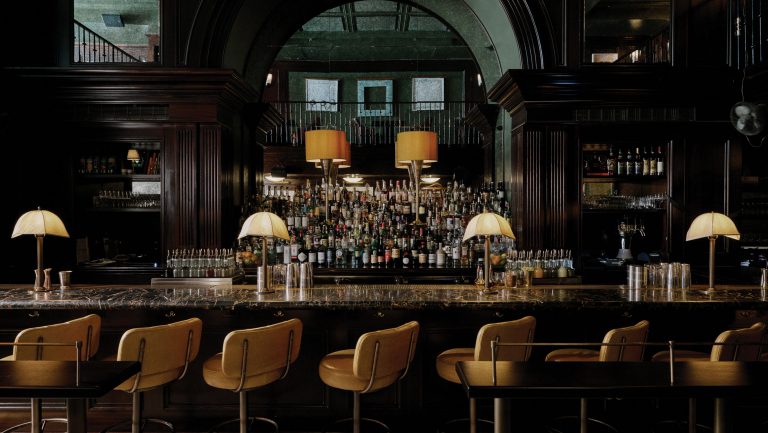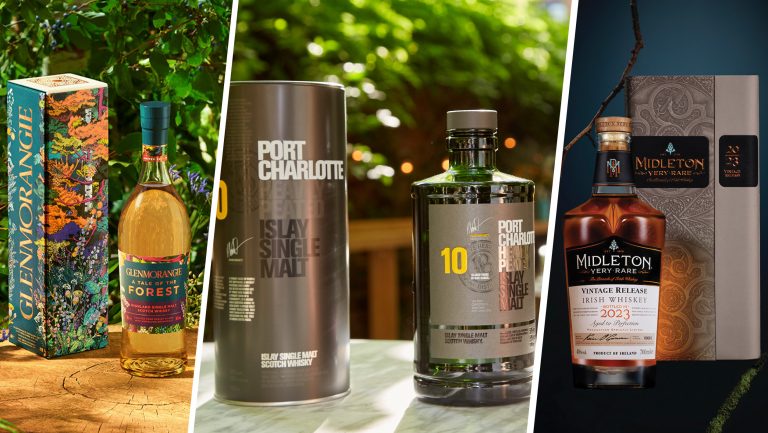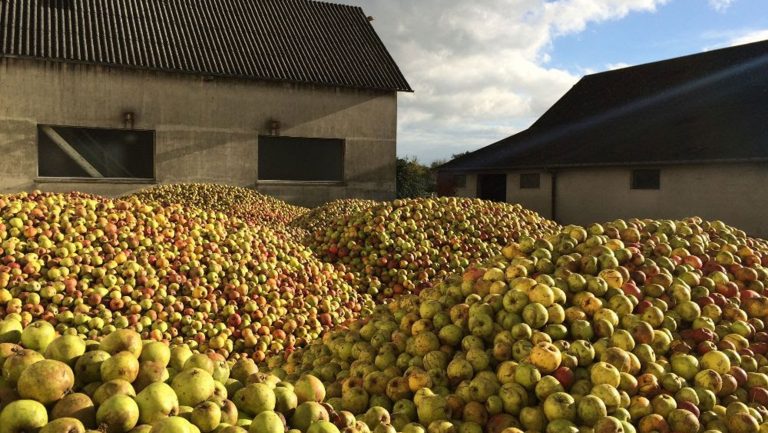When importer Leith Shenstone drinks the vermouths that his company, Fasel Shenstone, brings to the States, it’s often in a simple spritz: vermouth and bitters, with a splash of soda. And he has observed that these spritzes are an excellent gateway to aperitivo culture. While many casual drinkers have an aversion to vermouth, Shenstone finds that the taste of a simple vermouth spritz can change their mind. “People love them,” he says. “[They can] drink vermouth without having to be scared of the word vermouth.” Straightforward, low-proof, carbonated: Vermouth seemed like a perfect candidate for a canned cocktail.
The process of transforming it into a line of canned drinks took two years. Shenstone collaborated with Mancino Vermouth, whose products his company imports from Italy, and Scrappy’s Bitters, which had already debuted its own line of canned cocktails, Half Seas.
The resulting spritz, called Sprezza, sounds simple, particularly given the ingredients involved: the vermouth—either a white, Bianco, or red, Rosso—orange bitters, and soda. But producing a viable canned version of even the simplest cocktail poses some challenges.

Don’t miss the latest drinks industry news and insights. Sign up for our award-winning newsletters and get insider intel, resources, and trends delivered to your inbox every week.
Scheduled to launch in five states by January 2019, followed by a larger rollout in the spring, Sprezza is part of an emerging trend: premium ready-to-drink (RTD) cocktails for consumers accustomed to craft cocktails. And many of the new players in the RTD cocktail space come from a beverage background. Often, they’re distillers looking to highlight their spirits in a canned drink, or bartenders keen on using the format to market their own cocktails.
“It seems to me that a lot of the existing commercial players have the right idea but have a hard time executing,” says Shenstone. “They’re not thinking about the ingredients first. It’s ‘Here’s a cocktail idea—how do I make something decent?’ Not ‘Let’s think about the liquid we have, and go forward from there.’” Many of the newer-wave RTD cocktail entrepreneurs seem to be acutely focused on ingredients and production processes.
The Opportunities
A glance at the shelves of many liquor shops and grocery stores tells a clear story: The RTD cocktail category is on the rise. According to the Mintel Group, it’s a trend that will continue. The company’s December 2017 RTD Alcoholic Beverages report forecasts a 24 percent gain for spirits-based RTD cocktails for the period from 2017 through 2022.
Of consumers who reported drinking RTD beverages, 26 percent said they drank more of them over the last year, citing “better selection of flavors,” “more premium offerings,” and “better selection of craft offerings” as the top three reasons for doing so, which suggests there’s a lot of potential in the market for these products.
What’s more, the report notes, other categories demonstrate that the perception of canned drinks as being of lower quality is changing. Canned wine, almost unheard of before 2015, now appears on the shelves of wine stores nationwide. Canned craft beers are rapidly gaining in market share against their bottled counterparts. Cans are no longer the territory of mass-market beers alone.
All the purveyors SevenFifty Daily spoke with for this article who have recently entered the canned cocktail market shared the impression that the existing offerings were lacking, that they tended to be reliant on artificial flavors and preservatives, were overly sweet, and were often made with malt beverages rather than being spirits based. “We saw the rise of spiked seltzer, and all the FMBs [flavored malt beverages] gaining popularity,” says Phin DeMink, a cofounder of Southern Tier Distilling Company in Lakewood, New York. “And alongside that, the [growth of the] craft cocktail movement. We thought the time was right to launch something spirits based and all natural, for craft cocktail drinkers.”
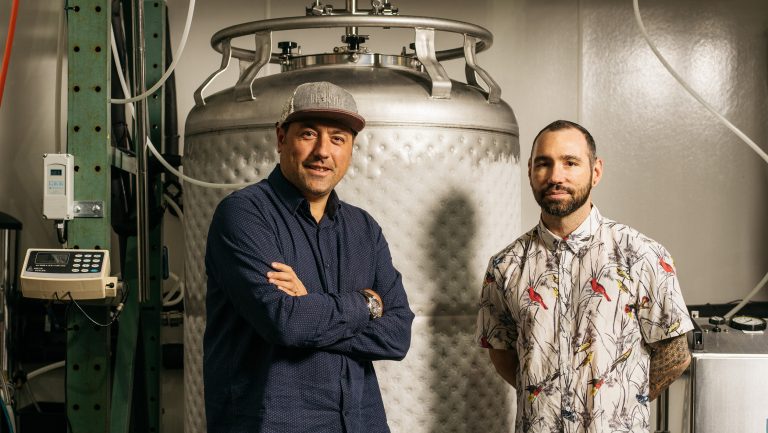
Miles Thomas, the founder of Scrappy’s Bitters, also points to cocktail bars as an inspiration. “Three or four years ago,” he says, “a lot of bars were doing bottled cocktails, or putting drinks on tap—experimenting with ready-to-drink cocktails in a bar setting. I wanted to take that format to market. And apparently the hive mind agreed, because so many others embarked on this journey at the same time.”
As a longtime Colorado bartender, Quinton Bennett, founder of Wheel House Cocktails in Denver, was keenly aware of the gap between craft cocktails and portable drinks. “I lived in Steamboat Springs for 15 years,” he says. “We’re skiing and biking and camping all the time, but other than craft beer, there weren’t any good canned drink options.” This was his inspiration to launch the cocktail line—leveraging his bartender’s expertise to create canned drinks of a craft cocktail caliber.
Creation
Shenstone didn’t expect the development of Sprezza to be easy—but given the ingredients he and his collaborators were starting with, it did seem that it should be straightforward. “Vermouth is already a cocktail in a bottle,” he says. “Bitters are already such an intense, concentrated flavor. We’re two small companies that can be accountable for the ingredients.”
The biggest challenge, the group quickly found, was the sugar level. “It immediately made sense why so many products on the market were too sweet—or just not balanced,” says Shenstone. “Carbonation affects sugar. The sugar latches onto the bubbles, so the more carbonated a drink is, the less sugar you taste.” With only three ingredients, it wasn’t possible to adjust the sugar levels easily. Changes had to come through the balance of the ingredients themselves.
Melissa Katrincic, a cofounder of North Carolina’s Durham Distillery, had a vision based on her distillery’s existing product line. She wanted to create a canned gin and tonic that would highlight the unique qualities of Durham’s spirit, for which certain botanicals are vacuum distilled. She was also interested in a vodka soda made with the distillery’s cold-distilled cucumber vodka. “Our goal,” says Katrincic, “is to maximize what technology can do for the ingredients.”
As with Shenstone’s Sprezza, even these simple drinks proved complicated. Katrincic laughs, saying, “If we knew everything that we’d have to figure out at the beginning, we might never have done it!” Many problems arose, especially during canning. Since neither the mobile canning operation they hired nor the craft breweries that canner usually worked with had any experience with spirits, much of the canner’s expertise did not apply. “There’s no yeast,” she explains, “so you don’t know how much head there’s going to be, how much foaming, where the fill line should be.” Calibrating the equipment ended up being a process of trial and error. “The first canning run we did, we had a 30 percent product loss. My heart sank as we watched it go down the drain.” But the second run was much more successful.
Ingredient Selection
Achieving shelf stability with fresh ingredients is another challenge in creating canned cocktails. Many cocktail staples—citrus and herbs, to name only two—are perishable; successfully getting them into a canned product is complicated.
DeMink developed Southern Tier’s cocktail prototypes with fresh ingredients at the distillery’s tasting room bar. “We knew it would be a challenge to commercialize those drinks,” he says, “and still have that natural flavor.” After speaking with five potential partners, Southern Tier chose to work with a group that specializes in shelf-stable juices. While that process is proprietary, DeMink says, “we do have real juice in the products. You can see the natural oils; there’s some haze to them. It was a big challenge and took a lot of R&D, but they’re shelf stable.”
Wheel House’s Bennett built his three canned cocktail concepts from cocktail templates he knew from his bartending experience would be popular. For example, he says, “people at cocktail bars ask for vodka, citrus, not too sweet.” With that request in mind, he developed a vodka-based cocktail with a mint-cucumber-elderflower syrup and lime. Sourcing produce at a larger scale, however, was a challenge at first. It’s one thing to find a good mint supplier for a cocktail bar, Bennett says, but quite another to order 200 pounds of fresh mint in one go.
Challenges for the Category
Since there are many laws and regulations that differ throughout the 50 states, the launch of any alcoholic product requires a significant amount of due diligence. “I have a huge, old-fashioned wooden desk,” says Shenstone, “and thank God, because it’s buried in paperwork from states across the country.” While canned cocktails tend to have similar ABV levels to beer and wine, they’re regulated differently, according to components. A drink like Sprezza, made from vermouth—and therefore wine-based—is classified as wine in every state. But because of its ABV level (5.5%), it can be sold in grocery stores in states such as New York and Connecticut, where beer and wine can be sold in such stores only if under 6% ABV. “It would be a massive blow to not be in grocery stores,” says Shenstone. “We want people to pick these up from the store when they’re buying snacks for a party, not to make a stop elsewhere.”
Because Katrincic’s was the first spirits-based RTD product line to be launched in North Carolina, a control state, she ran the risk that Durham Distillery’s canned cocktails wouldn’t be approved at all. “You have to develop a whole product line—get it fully done and packaged—before you can submit it,” she says. “If [the North Carolina Alcoholic Beverage Control (ABC) Commission] says no, you can’t even sell it at your own distillery. So we were at risk for 10 months. We were prepared for a no, and it’s hard to launch a product that way.” Approval came in late July of this year, and the product line was shipped to ABC stores several weeks later.
In North Carolina, spirits-based RTDs are, in some ways, at a disadvantage. “Malt beverages,” Katrincic explains, “can be in grocery stores and convenience stores, [but] we can’t.” She does think, however, that customers are coming to appreciate the difference between a flavored malt beverage and a true cocktail, and that they’re willing to buy the latter at a liquor store. “We’re surprised,” she says, “by how popular they’ve been.”
Positioning the Product
After Scrappy’s launched its Half Seas canned cocktail line Thomas and his team paid attention to how the products were being retailed and how consumers were making purchasing decisions. For example, says Thomas, “people like to try a single can before they commit to a four-pack.” Pricing and sizing are also concerns. Craft cocktails, on a shelf next to far cheaper and often larger hard seltzers, don’t seem to offer value. “But we have to be steadfast and hold our position—that this is a true cocktail in a can,” says Thomas. “They’re not equivalent.”
In making final adjustments to Sprezza, the collaborators had to focus on the real audience for their canned cocktail: everyday consumers. After he had a number of industry professionals sample Sprezza, Shenstone says he realized that beverage professionals look for a different flavor profile than consumers do. “Bartenders tend to want more flavor, more vermouth,” he says. “Bitter is better, aggressive is better. But I don’t think consumers necessarily think that way.”
As portable, easy-to-drink, and shelf-stable products, canned cocktails are intended to be consumer friendly. Convenience and accessibility are, in a way, the whole point. “Ready-to-drink cocktails shouldn’t be a cerebral experience,” says Shenstone. “We want to introduce people to a style of aperitivo that they might not create on their own—with interesting flavors but not something they have to think too hard about.” The challenge, then, is to create straightforward drinks with widespread appeal that meet the higher standards of today’s spirits-savvy consumers—a goal that each of these brands, in its own way, is endeavoring to meet.

Dispatch
Sign up for our award-winning newsletter
Don’t miss the latest drinks industry news and insights—delivered to your inbox every week.
Carey Jones is the author of Brooklyn Bartender: A Modern Guide to Cocktails and Spirits and a frequent contributor to Food & Wine, Travel & Leisure, Saveur, and many other publications. She is a former managing editor of the James Beard Award–winning website Serious Eats.

